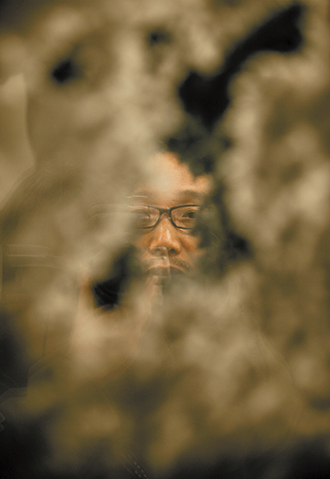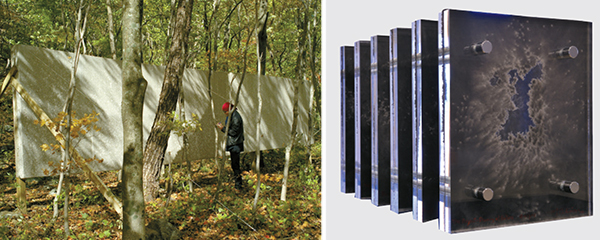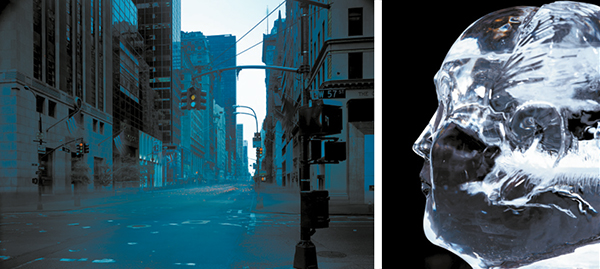The whole world is a canvas for Kim Atta

Kim Atta
He is always taking a leap, staying one step ahead of critics, curators and gallery owners who think they’ve managed to catch up with his productions. He captivated art-lovers with his “Monologue of Ice” series and a photo of New York that had been exposed for eight hours in his 2006 show “Atta Kim: On-Air” at the International Center of Photography in New York. Then he moved on to present the monochrome, minimalist space of the “Indala” series.
Having been named Korea’s representative to the twenty-fifth Sao Paulo Biennial in 2002, he has since made his name known to wider audiences by having his works featured at the 2009 Biennale Collateral Event held in Venice.
While on his way to becoming an internationally acclaimed photographer, the 57-year-old put his camera away and started putting physical changes of environment onto massive canvasses that are exposed to the surrounding landscapes in “The Project-Drawing of Nature.”
These canvasses have been installed in such diverse areas as Bodh Gaya in India, the Greek Island of Paros and China’s Henan Province as well as Manhattan, Siberia and Tibet for a total of 44 different places. He is now set to unveil 22 of them in Korea.
In the works, he extracts part of nature on his blank boards. Traces of mold, rain drops, wind and sunshine have been left on his works. A canvas installed near the beach in Geoje Island bears the tracks of various sea creatures while one at a shooting range in the Demilitarized Zone evokes shards of broken glass, evolving into an abstract frame.
Art is usually defined as something artificial and beyond nature, but Kim’s works emerge from a collaboration with it.
The JoongAng Sunday sat down with Kim at his studio in Paju, Gyeonggi to discuss his concept of art and his future plans.

Left: Kim Atta installs a work in a forest in Korea as part of “The Project-Drawing of Nature”; he has set up works in 44 cities around the world. Right: “The Target #013” (2012) was placed at a shooting range at the DMZ. Provided by Kim Atta, Jeon Ho-sung
Q. You have shifted your approach between “Deconstruction,” “Museum Project,” “On-Air” and now “The Project-Drawing of Nature.” The style of your works has radically changed.
A. I think they’re basically the same. Both photography and canvasses are affected by light, rather they’re the result of light. I wrote a book titled “Water Does Not Soak in Rain.” That comes from the idea that water and rain both are basically H2O but have a different name. I sought to transcend this kind of distinction and find a state of non-dimension. I’ve never changed and remain the same since I first took on my job. I’ve always worked with the same determination and commitment.
What made you install a canvas exposed to nature?
In 1995, I had already set up two canvasses outside near my studio in Gijang, South Gyeongsang. I found consolation in watching the changes occurring on them. More important motivation came when I saw Joseph M. William Turner’s paintings in New York. I cried a lot thinking he painted pictures until the end of his life. I didn’t want to live like him. I’d taken too many pictures that took too much work and walking, and was entangled with a number of relationships until the “Indala” series. Ten thousand photos from “On-Air” were translated into the “Indala” series, which I think is the climax of my works. There was a moment that I felt as if I exploded and the moment was blessed with wisdom. All things flow as they are and led me into this project.
That’s why I put away my camera. More precisely, I stepped away from the demands of contemporary art. I might pick up my camera again, but it would mean something different compared to the past.
How have your friends reacted?
I got a lukewarm response in Korea. Some said I might fail and others were just not optimistic. But the “Drawing of Nature” project explains my existence as an artist. I pushed and pressed myself like I would leave behind what I’ve done for this project. Unlike my Korean friends, my foreign friends were very supportive and encouraged me. Some of them helped me get permission to find overseas locations like Santa Fe or New York, which were known to have strict standards. I really appreciate their help.
How did you go ahead with your project despite the unfavorable reaction?
Artists are not bound to work painfully. Some artists sometimes try to take advantage of a widely held perception that all artists work in a hostile, desperate environment. That’s an insidious way of fooling others in an attempt to win more bread.
Different conversations inspire my works and communication always requires something new. And I create something new by putting my hands on things. I’ve honed my skills to communicate with a range of objects and the world.
How do you feel you can heal human beings by setting up canvasses in Hiroshima and Auschwitz?
Wounds never heal unless the cause of the injury is cleared. The best way to sort things out is to confront the pain and converse with it. The process can be euphemistically called “conversation,” but it never disappears without facing it, no matter how tiny the wounds are. One should reach the state of contemplation and embracement. If one goes beyond the limits to an extreme length, one will feel united with certain objects.
It could take a moment, or sometimes a month or a year or even several years to reach that state. After passing through the stages, the moment of deconstruction finally arrives. Deconstruction represents novelty and the novelty defies conventions and widely held conceptions.
I will keep asking myself how the canvasses near Hiroshima and Auschwitz can play a role in easing the wounds. And these kinds of questions will make the project more meaningful and valuable. The canvasses standing there become a medium for memory and reflection.

This eight-hour-long exposure of New York City, left, is part of Kim’s “On-Air” project. His “Monologue of Ice” series, right, delves into the fleeting nature of the world.
What do you make of the notion of beauty?
People live to become beautiful. Beauty is the beginning and the end. I learned that one should go to extremes to appreciate meditation. I’ve never limited myself and struggled throughout my life. The process sometimes accompanies deep-down loneliness and solitude but that’s where no discrimination exists. It’s too calm and tranquil. The experience is reflected in my works, making the art pieces more beautiful.
How did you make a decision when selecting the 44 locations?
Every part of nature, society and place has its own story. I want to maintain the existing significance of each place while presenting different perspectives. I once talked with an old Native American woman all day long on an Indian reservation. It was an extremely moving experience. I came to know why they are so pure. My work is part of a process of restoring a long-forgotten story and easing the pain in history.
How have the residents of each area reacted?
Most of them have really enjoyed it. The head of a research center for Laotzu’s philosophy asked me to mull over how to express eastern philosophy on the canvas. We met at an event held by the United Nations in China.
I soaked a napkin with kaoliang [Chinese sorghum wine] spirits and let it sway. People there, including police chiefs and wealthy community leaders, seemed to understand the concept.
Sometimes, residents are not that welcoming. I’ve spent four years getting permission from Auschwitz.
As the display goes on, some people volunteer to help me. Hongcheon County, Gangwon, was also very cooperative. I recently got calls from abroad. A rich man living in Greece suggested I set up a canvas along the silk road connecting Paris and Beijing. It’s getting more interesting.
What are your future plans?
I’ve done one third of the project. I’m trying to install canvasses in Poland, four countries in Africa, Auschwitz, Paris and Scandinavia in the first half. In the latter half, I want to set up the boards across conflict zones including Jerusalem, the Andes and Palestine.
Actually, the remaining countries will be reluctant to let me get in. But I will keep carrying out the project and one day I’d like to set up a canvas in every city around the world, and even in space.
When I worked on the “Indala” series, some were concerned as to whether there’s anything remaining to venture into. And now they’re worried about what kind of project I can embark on after finishing the “Drawing of Nature” series. But I’m not worried because all I can do is concentrate on the present and the intense focus will lead me to the next project.
By Lee Jin-suk [ejpark@joongang.co.kr]










with the Korea JoongAng Daily
To write comments, please log in to one of the accounts.
Standards Board Policy (0/250자)